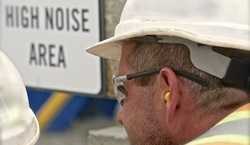Cross-sectors
The cross-sectors focus on the major health and safety issues affecting the U.S. working population.
Cancer, Reproductive, Cardiovascular and Other Chronic Disease Prevention
Includes many types of occupational cancer, reproductive health, and cardiovascular disease as well as the evolving areas of occupational neurological and renal disease.

Hearing Loss Prevention
Focuses on prevention of occupational hearing loss due to hazardous noise exposure, ototoxic substances (chemical, pharmaceutical, metals) and the development interventions through research in surveillance, engineering noise control, personal protective equipment and best practices.
Immune, Infectious and Dermal Disease Prevention
Includes the study of work-related immune diseases, such as irritant and allergic contact dermatitis, allergic rhinitis, asthma, or infectious disease, caused by work-related exposures. It also includes workplace exposures to chemicals that can be absorbed through contact with skin that may result in adverse health impacts.

Musculoskeletal Health
Focuses on preventing musculoskeletal disorders, which are soft-tissue injuries caused by sudden or sustained exposure to repetitive motion, force, vibration, or awkward positions.
Respiratory Health
Advances primary and secondary prevention addressing a range of hazardous exposures and their adverse respiratory health effects including lower airways diseases (e.g., asthma, chronic obstructive lung disease); upper airways diseases (e.g., rhinosinusitis); interstitial lung diseases (e.g., coal workers’ pneumoconiosis, asbestosis, silicosis); respiratory infectious diseases (e.g., tuberculosis, influenza, anthrax, emerging infectious diseases); respiratory tract and pleural malignancies (e.g., lung cancer, mesothelioma); and emerging exposures and related diseases (e.g., engineered nanomaterials, World Trade Center dust, flavoring chemicals). In addition to preventing work-related respiratory disease, seeks to improve workers’ respiratory health.
Traumatic Injury Prevention
Focuses on preventing injuries and related deaths to workers due to sudden events such as falls, motor vehicle crashes, violence, and being caught in or struck by machinery.

Healthy Work Design and Well-Being
Seeks to improve the design of work, work environments, and management practices in order to advance worker safety, health, and well-being. Within the healthy work design framework, worker well-being encompasses positive physical, emotional, mental, and economic health, and how these aspects of health relate to work and worker experiences from a comprehensive and holistic perspective.
More information about NIOSH’s work in each cross-sector can be accessed through the NIOSH Program Portfolio page.
- Page last reviewed: July 27, 2016
- Page last updated: July 27, 2016
- Content source:
- National Institute for Occupational Safety and Health (NIOSH) Office of the Director


 ShareCompartir
ShareCompartir